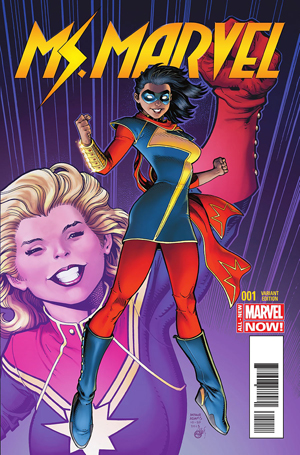“Ms. Marvel,” the new ongoing comic book series from Marvel Entertainment, has gotten quite a bit of buzz over the last few months in both the comics community and the mainstream media. Originally announced at New York Comic Con in October as part of Marvel’s “All-New Marvel Now!” initiative to reach out to new comic book readers, the series has since been covered in publications such as USA Today and The New York Times.This flurry of media attention is ostensibly due to the fact that Kamala Khan, the civilian identity of the titular Ms. Marvel, is a Muslim American teenager.
Though Kamala certainly isn’t the first Muslim superhero in comics, the industry isn’t exactly inundated with Muslim characters, and she is the first one to have her own self-titled series published by a mainstream company. Brought into existence by the creative team of writer G. Willow Wilson, artist Adrian Alphona, and colorist Ian Herring, “Ms. Marvel” #1 is a nearly perfect first issue.
A seasoned comic book writer known for her work on the Vertigo Comics series “Air” and her novel “Alif the Unseen,” Wilson is herself Muslim, and clearly knows how to construct complex characters. Though initial descriptions of Kamala’s life in interviews made me concerned that the characters would be strictly adhering to flat Muslim stereotypes, these concerns were mitigated after the first three pages. Unlike previous Muslim comic book characters, such as the X-Men’s “Dust,” Wilson’s characters are not characterized solely by their Muslim heritage but instead are treated as real people with real thoughts, feelings, and motivations.
In the few pages that each of them are given, Wilson masterfully provides her characters with rich, nuanced personalities through her crisp dialogue. For instance, Kamala herself is shown to be quirky, shy, and awkward, while her friend, Nakia, is cold, critical, and unafraid of shutting down ignorant individuals. Though Kamala’s family members aren’t given as well-defined personalities, it’s important to note that this is the first issue of an ongoing comic book series, and it is likely they’ll receive further definition and development in later issues. Additionally, in the small amount of space that the Khans are given, Wilson does successfully distinguish them from one another, demonstrating that they each have different ideas about what it means to be Muslim.
The plot for this first issue is relatively simple and not wholly original, stemming from a disagreement between Kamala and her parents regarding a party, but as a way to introduce us to an entirely new cast of characters in an unexplored corner of the Marvel Universe it certainly works. By the end of the issue, we have a concrete idea of who Kamala Khan is and what her world is like. And if you aren’t endeared enough with Kamala’s world by the end of the first issue to come back for the second, the cliffhanger on the final page will certainly convince you otherwise.
Throughout the entirety of the issue, Alphona is in top form. Alphona, who hasn’t consistently drawn a monthly comic since the conclusion of his stint on Marvel’s “Runaways” in 2007, has clearly been honing his skills. While his “Runaways” art was stellar, Alphona’s “Ms. Marvel” art is on an entirely new level. Alphona’s characters are all distinctive, with varying body types and facial features, which is a rarity in superhero comics. In his artwork, Alphona does demonstrates a strong understanding of not only human anatomy, but also humans as emotional beings. He is able to clearly express the characters’ unique personalities, giving them accurate facial expressions and nuanced body language. Alphona, who originally worked in the fashion industry, also gives each character his own unique wardrobe, further accentuating the distinct personalities already provided for them through Wilson’s dialogue.
Herring adds even more life to Alphona’s already vivid artwork. His colors adhere to an atypical palette for a superhero comic in that it is not a strictly “realistic” palette and has a strong presence of yellows, blues, and greens. The effect is gorgeous, making each individual panel of every page a lush, detailed illustration all on its own.
I only have a few minor complaints about this issue. Every once in a while, Wilson’s dialogue feels awkward or stilted, and on occasion characters’ expositions about Islam feel unnatural. I would also argue that the artwork during Kamala’s visionary dream sequence towards the end of the issue—both Alphona’s linework and Herring’s colors—adhere too closely to the way the comic depicts the real world. The content of the dream sequence itself, too, may be hard to fully understand for readers unfamiliar with Marvel Comics superheroes. Ultimately, however, these small problems do not detract from an otherwise fantastic issue.
With its well-defined cast, strong script, and gorgeous artwork, Ms. Marvel #1 is a shining example of how to properly launch a new comic book series. Though this first issue is not without flaws, none of them are large enough to interfere with the overall experience of the book. Whether you are an experienced comic book fan or someone looking for the opportunity to jump into the Marvel universe, “Ms. Marvel” #1 is a stunning debut issue that deserves your attention.

Comments are closed